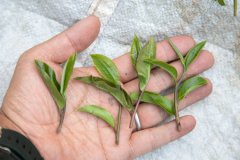Can I drink tea overnight? What harm does drinking do to your health? You can't drink tea after brewing it several times.
When making tea, sometimes you stop brewing tea once or twice. We often wonder whether we should continue to brew it. Sometimes we may think that brewing methods, such as kung fu brewing or traditional Chinese brewing, or even the type of teapot, will determine how long the tea can be kept fresh to how many times. In my opinion, in the same way of brewing, the type of tea is the key determinant of keeping fresh. Here, the type of tea refers to the way of growing tea, not the type of tea. Some people may think that the brewing time of green tea is not long, while that of Pu'er tea is long. In this article, I use Japanese green tea as my research model to study the factors that determine the brewing time. The way of growth affects the rate of deterioration in ordinary tea gardens, teas that use nitrogen fertilizer (whether organic or chemical) usually rot faster. After brewing and leaving for 24 hours, the tea often produces a bad smell like raw garbage. However, unfertilized natural agricultural tea trees remain fresh after being preserved for the same period of time. The leaves made from natural agricultural tea will not produce an unpleasant smell after 24 hours. We can continue brewing the next day. The bad flavor of non-natural agricultural tea is not caused by microbial decay, but by the oxidation of amino acids. The higher the content of amino acids in tea, the faster the odor will be produced. The relationship between nitrogen and fertilizer in tea the content of amino acids in tea varies greatly, which depends on the growth pattern of tea trees. The results of quantitative analysis showed that the more nitrogen was applied, the higher the content of amino acids per unit area of tea was. The content of polyphenols decreased with the increase of nitrogen application rate. If there is no fertilizer or less fertilizer in the process of tea planting, the content of polyphenols will increase. Comparison between naturally cultivated tea and fertilizing tea We chose two different types of Japanese green tea to observe the effect of fertilization. The one on the right is produced in an ordinary tea garden that uses a lot of nitrogen fertilizer. I can taste the uncontrollable taste (the taste of amino acids). The other one on the left is tea grown by natural farming, which does not use fertilizer at all. At first, after the first brewing, the tea grown with fertilizer was bright green. After ① nitrogen application, the leaves absorbed nitrogen, the growth rate accelerated, chlorophyll synthesis increased, and photosynthesis enhanced. This is the mechanism by which tea leaves grown with fertilizer turn tender green. The observation of making tea is naturally grown tea on the left and fertilized tea on the right. The tea on the right is steamed a little deeper. We choose both kinds of tea with stems to adjust the situation. Due to the characteristics of naturally grown tea, even if it is fresh, it will show yellowish green. 12 hours: the naturally grown tea on the left still smells very fresh, while the tea on the right loses its fresh flavor. 24 hours: the naturally grown tea on the left still gives off a very fresh floral fragrance, while the tea on the right gives off an unpleasant smell for 36 hours: the tea becomes a little cloudy. This indicates that there are some microorganisms growing at this stage. To my surprise, the naturally grown tea still exudes a fresh fragrance. On the first day, the tea grown with fertilizer was fresh green. After 12 hours, its color lost its brightness and brightness, and it turned brown after 24 hours. On the contrary, the naturally grown tea leaves remained stable yellow from the beginning to the end, without causing brown changes. In terms of aroma, naturally grown tea leaves showed a floral fragrance after 12 hours, while those grown with fertilizer lost their fresh aroma. After 24 hours, the naturally grown tea still smells of flowers, although it is not fresh after brewing. As tea grows under the action of fertilizer, it gives off an unpleasant smell like rotten vegetables. 24 hours later, the color of tea soup: the color of naturally planted tea did not change much, but the tea planted with fertilizer was brown.

Fresh taste can cause the tea to deteriorate, which contains less free amino acids. Even if the soaked tea is left for several hours, it can remain fresh and floral for a long time. The reason why the tea grown with chemical fertilizer produces a bad taste is mainly due to the Merad reaction. Maillard reaction is the oxidation of amino acids and sugars. Amino acids, known as delicacies, are involved in this reaction. In Japanese, umami refers to the taste of amino acids. Because of the confusion of the word, it often leads to the misunderstanding that more umami means more delicious. In fact, delicacy is just a term describing the taste of amino acids. Delicacy has nothing to do with delicacy. For us, and for many tea lovers in China and Taiwan, the aftertaste of tea determines the quality of tea. Unfertilized tea is rich in polyphenols. The aftertaste of this tea is very long, and its freshness can be maintained for a long time. I often continue to brew tea within 15-16 hours, which is only suitable for naturally grown tea. No matter what kind of tea I put on one night, the only fresh taste I can enjoy is naturally grown tea. Relatively speaking, the freshness of oolong tea can be maintained for a long time, even if it is not naturally cultivated tea. Oolong tea is picked later, ie when the tea grows bigger. It contains less amino acids, but polyphenols. If you need to leave while making tea, I suggest that the best thing to do is to put the brewed tea in the refrigerator. Due to the low temperature, the oxidation rate is slow. We can enjoy its freshness for a longer time.
Important Notice :
前街咖啡 FrontStreet Coffee has moved to new addredd:
FrontStreet Coffee Address: 315,Donghua East Road,GuangZhou
Tel:020 38364473
- Prev

What is the taste of Yunnan black tea? Is black tea expensive in mountain purple tea in Yunnan, China?
Why can high altitude produce good tea? All the time, we humans inhale oxygen and release carbon dioxide. As for plants, there are two different ways. During the day, plants absorb carbon dioxide and release oxygen. They carry out photosynthesis and produce energy and other components. Instead, plants absorb oxygen at night and release two.
- Next

What is the difference in the price of tea in different seasons? Is the tea better before or after the rain?
The quality of tea varies from year to year depending on the weather and climate. It's like wine. In particular, the condition of Rain Water has a great influence on the quality of tea. If there are more Rain Water in the harvest season, the quality of tea will decline. The taste of agricultural products harvested in rainy days is very light, but the taste of tea picked in rainy days is very light afterwards.
Related
- What effect does Italian American coffee with filter paper have? Will coffee taste better if it is put on filter paper at the bottom of the powder bowl?
- What is the color difference in coffee beans? What are the characteristics of honey processed coffee beans? Why are the anaerobically treated coffee beans uneven in color?
- How does novice Xiaobai quickly get started and make coffee? Newbies learn to make coffee by hand and share the specific steps and process process!
- Costa tea has a shelf life of 100 years?! Expert: Unable to verify
- It's a huge uproar! American milk addition was rejected by Manner employees?!
- Mocha pot coffee bean recommendations| How fine and how much powder should be used for grinding? What parameter ratios do I need to use to make milk with Mocha pot coffee?
- What are the characteristics of the world's top ten coffee beans treated with Costa Rica honey? How to make black honey kadura from Tarazhu Pilon Processing Plant taste good?
- How to make deep-roasted coffee? What grinding water temperature does authentic Jamaica Blue Mountain No. 1 coffee use to brew it well?
- Selected high-grade rose summer coffee flavor tasting guide Why Panama rose summer has the aroma of flowers and fruits
- What equipment does a novice Xiaobai need to buy to learn to make coffee? Filter cup electronic scale bean grinder manual flushing pot purchase guide

